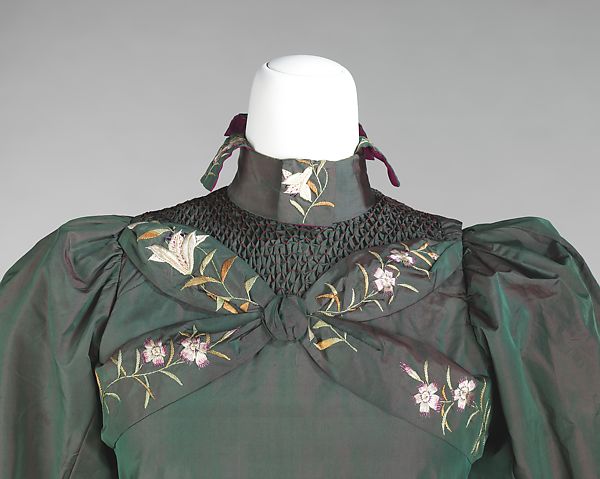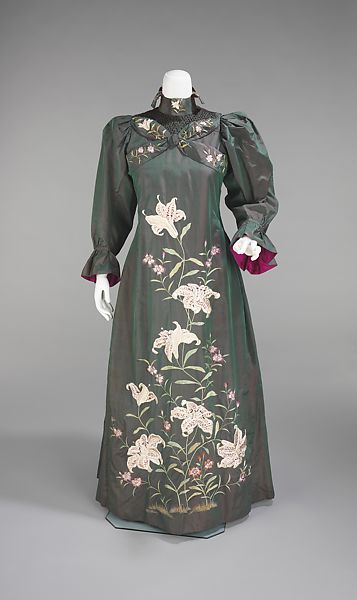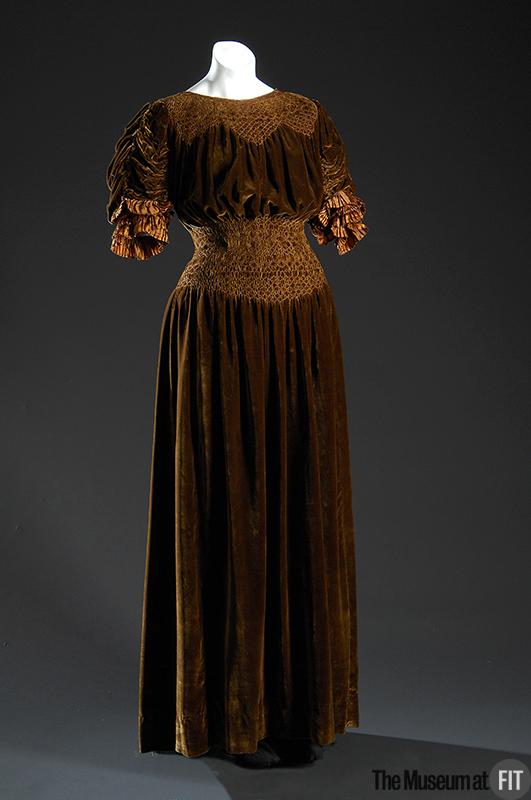This late 19th-century embroidered tea gown combines design features of several artistic movements of the time, including historicism, Japonisme, and Art Nouveau.
About the Look
T his tea gown epitomizes the aesthetic movement of the late nineteenth-century in several ways.
It is high-necked, with decorative ribbons protruding from the collar (Fig. 1). It features smocking that begins at the collar and continues to the shoulders. A large bow of the same fabric decorates the chest. The long, puffed sleeves are gathered at the shoulder-seams and around the wrists, producing a ruffle effect. The back of the gown resembles the so-called Watteau (or box) pleats (Fig. 2) characteristic of eighteenth-century robes à la française.
The main dress fabric is a green silk taffeta, lined in magenta (as is visible at the cuffs). Embroidered lilies and natural forms serve as embellishments throughout the body of the garment. Large, sinuous lilies in an asymmetrical design climb up the front of the gown stopping at the bust. They also decorate the ribbon details, as well as the top of the Watteau-pleated back.
There is no label to identify the maker of this tea gown. However, based on the smocking, The Metropolitan Museum of Art, which owns the dress, believes the gown may be attributed to the British department store Liberty & Co, which was associated with the commercial production of 19th-century dress reform garments, as will be discussed below.
Fig. 1 - Possibly Liberty & Co. (British). Tea Gown, 1898–1901. Silk taffeta. New York: The Metropolitan Museum of Art, 2009.300.558. Gift of the Brooklyn Museum, 2009. Source: The Metropolitan Museum of Art
Fig. 2 - Possibly Liberty & Co. (British). Tea Gown, 1898–1901. Silk taffeta. New York: The Metropolitan Museum of Art, 2009.300.558. Gift of the Brooklyn Museum, 2009. Source: The Metropolitan Museum of Art
Tea Gown (British), 1898-1901. Silk taffeta. New York: The Metropolitan Museum of Art, 2009.300.558. Brooklyn Museum Costume Collection at The Metropolitan Museum of Art, Gift of the Brooklyn Museum, 2009; Designated Purchase Fund, 1986. Source: The Metropolitan Museum of Art
About the context
T his tea gown is dated to the turn of the century, ca. 1898–1901. Tea gowns were worn indoors for five-o-clock tea, and enjoyed immense popularity in England and France from the late 1870s through the first decade of the twentieth century (Bissonnette 271-2). They were often designed to be, or at least to appear, comfortable as they were typically loose at the waist and thus did not require corsetry to achieve the desired silhouette. When tea was first introduced to Europe in the early seventeenth century, it was incredibly valuable and exotic, and reserved for the elite classes (Bissonnette 271). While tea had certainly been democratized by the nineteenth century, the highly ritualized and exclusive social event of “teatime” appealed to the aspirations of the middle class (Bissonnette 271).
Teatime originated not only the tea gown, but also heavily influenced interior spaces – namely the parlor room (Bissonnette 271). Although teatime occurred in private homes, they were somewhat public events. Therefore, parlors were essentially “public stages,” and the hostess would take great care to display her artistic taste (Bissonnette 271). It was common for the interior decoration of a late-nineteenth-century parlor to be fashionably artistic and exotic, and the hostess’ tea gown ideally matched the interior (Bissonnette 271). Mrs. Eliza Haweis wrote about this trend in the British ladies’ magazine The Queen in 1878:
“A great change has come over the style of English dressing within the last, say, five years. The world of artists first started the idea of their wives and daughters dressing in harmony with [their] surroundings, and thence the grandes dames of fashion were influenced.” (Cullen 139–140)
Tea gowns were an element of Aesthetic dress, associated with pioneers of the Aesthetic movement (Cullen 7-9). One such pioneer was Arthur Lasenby Liberty, who founded Liberty & Co. in 1875 (Ashmore 479). Liberty & Co. was a renowned London department store that initially specialized in exotic handmade goods from what was then called the Middle and Far East (Ashmore 479). While the business was originally based on imports, eventually Liberty began producing their own Eastern-inspired fabrics (Fig. 3), and opened a dressmaking department in 1884 (Fig. 4) (Cullen 7-9). Liberty’s designs became famous for not requiring the corsetry otherwise expected of Victorian women.
Another designer and early dress reformer was Henry Van de Velde, who in 1902 published an article titled “Das neue Kunst-Prinzip in der modernen Frauen-Kleidung” (“The New Art Principle in Modern Women’s Clothing”) in the magazine Deutsche Kunst und Dekoration (German Art and Decoration). In photographs accompanying the article, several garments have the same silhouette as our tea gown (Fig. 5).
Fig. 3 - The Silver Studio for Liberty & Co. Ltd (British). Woven sample, ca. 1895-1900. Jacquard woven cotton; 26 x 36 cm. London: Victoria and Albert Museum, T.485:5-1996. Given by Paul Reeves. Source: Victoria and Albert Museum
Fig. 4 - Liberty of London (British). Dress, ca. 1910. Silk velvet. New York: Museum at the Fashion Institute of Technology, P90.83.2. Source: Museum at the Fashion Institute of Technology
Fig. 5 - Henry Van de Velde (Belgian, 1863-1957). Photo printed in "Das neue Kunst-Prinzip in der modernen Frauen-Kleidung", 1902. Print. Heidelberg: Heidelberg University Library, 10.1902. Source: Heidelberg University Library
Fig. 6 - Artist unknown (France or Italy). Robe à la française, ca. 1735. Silk taffeta brocade. New York: Museum at the Fashion Institute of Technology, 2006.56.2. Source: Museum at the Fashion Institute of Technology
Fig. 7 - Callot Soeurs (Paris). Tea Gown, ca. 1905. Silk damask, lace, lined with satin. London: Victoria and Albert Museum, T.148-1967. Source: Victoria and Albert Museum
Fig. 8 - Callot Soeurs (Paris). Tea Gown, ca. 1905. Silk damask, lace, lined with satin. London: Victoria and Albert Museum, T.148-1967. Source: Victoria and Albert Museum
Many tea gowns reflected the Victorian-era taste for eclecticism (an enthusiasm for a range of aesthetic styles) as this one does. In particular, the Watteau pleats on the back of the gown demonstrate historicism.
Nineteenth-century historicism can be described as the “revival, romanticism, and reinterpretation” of earlier periods (Kirkham & Ogata 422). Nineteenth-century Europeans felt that they had a very rich heritage, the styles of which could inform their present world. Among those revival styles are Gothic Revival, Renaissance Revival, and Rococo Revival (Kirkham & Ogata 422-426). While the term historicism is typically used to describe furniture and decorative arts, revival movements undeniably affected fashion as well – especially when dress was intended to match interiors.
The back of our tea gown resembles a “sacque” back or Watteau pleats that were characteristic of eighteenth-century robes à la française (Fig. 6). This is a feature of many turn-of-the-century tea gowns, including two in the collection of the Victoria & Albert Museum, one by Callot Soeurs, circa 1905 (Fig. 7), and the other by House of Rouff, circa 1900 (Fig. 8).
Brought about by rises in tourism, imperialism, and trade throughout the nineteenth century, a taste for “exotic” embroidery developed in nineteenth-century Europe (Kirkham & Ogata 426). Designs both imported from and inspired by the Asia were de rigueur. For example, the aforementioned House of Rouff tea gown (Fig. 8) features embroidery worked on in India for the European market.
However, while trade between Europe and most of Asia was well-established, it was only opened to Japan in the second half of the nineteenth century (Mears 440). In 1862, there was a significant Japanese display at The Great Exhibition in London – marking the official opening of the Japanese market to the West (Stavenow-Hidemark 873). This came to have a major influence on European design. The ensuing style of design was not truly Japanese, as it incorporated Western design ideals and was commonly conflated with other Asian cultures (Kirkham & Ogata 426). Therefore, the style is referred to as “Japonisme.”
The popularity of Japonisme was reflected in fashion, which by its nature constantly seeks out novelty and change (Mears 440). This was especially the case with relatively informal garments such as tea gowns and dressing gowns. The tea gown pictured in figure 9, in the collection of the Museum at the Fashion Institute of Technology, is circa 1870 and incorporates authentic Japanese kimono fabric. The quilted dressing gowns pictured in figure 9, in the collection of The Metropolitan Museum of Art, are circa 1880 and were created in Japan for the Western market.
Fig. 9 - Artist unknown (United States). Tea Gown, ca. 1870. Pink silk taffeta and embroidered crepe. New York: Museum at the Fashion Institute of Technology, 80.1.4. Gift of Florence Anderson and Mary A. Seymour. Source: Museum at the Fashion Institute of Technology
Fig. 10 - Artist unknown (Japan). Dressing Gowns, ca. 1880. Silk. New York: The Metropolitan Museum of Art, 1970.83a, b. Gift of Katherine Babcock Cavalli, 1970. Source: The Metropolitan Museum of Art
At the same time, this tea gown also reflects elements of the Art Nouveau movement. The embroidered lily motifs and their asymmetrical design are in line with the modern Art Nouveau style, which favored abstracted floral patterns and flattened pictorial space. In fact, no artistic movement better encompasses the nineteenth-century taste for eclecticism and mixing of styles than Art Nouveau. Starting around 1895, the Art Nouveau design movement was a “pan-European phenomenon” that celebrated newness and modernity while also borrowing from revival movements and exoticism (Geczy 115). In Fashion and Orientalism, Adam Geczy described it in this way:
“Art nouveau is the modern version of latter-day chinoiserie, this time mixing eighteenth-century rococo (said to come from rocaille, meaning stonework) with the new Japanese decorative universe; both styles were liberal interpreters of the natural world.” (115)
The embroidered lilies asymmetrically climbing up the front of the tea gown express some of the aesthetic values of Art Nouveau. It is very typical for floral designs in the Art Nouveau style to heavily incorporate “rhythmically swaying stalks” amongst large floral blooms (see Fig. 11) (Stavenow-Hidemark 874). Though the embroidery on the green silk tea gown is perhaps closer in style to that favored by the earlier Arts & Crafts movement that Art Nouveau assimilated. The embroidered lilies resembles those on an embroidered pillow cover (Fig. 12), circa 1876–1877, associated with the Arts and Crafts movement..
In the artistic exuberance of the turn of the twentieth century, dress commonly drew upon myriad of design influences – as this tea gown attests. Thus, a garment designed intended to be relatively informal also made a complex aesthetic statement about wearer, her tastes, and her fashionability.
Fig. 11 - Emile Pingat (French, 1820-1901). Opera Cloak, ca. 1882. Silk, fur, feathers, metal. New York: The Metropolitan Museum of Art, C.I.60.42.13. Gift of Mrs. Howard Crosby Brokaw, 1960. Source: The Metropolitan Museum of Art
Fig. 12 - Candace Wheeler (American, 1827-1923). Pillow Cover, ca. 1876–77. Wool twill embroidered with wool and silk thread, silk velvet border; (22 x 22.5 in). New York: The Metropolitan Museum of Art, 2002.355.1. Gift of Candace Pullman Wheeler, 2002. Source: The Metropolitan Museum of Art
References:
- Ashmore, Sonia. “Liberty & Co.” In The Berg Companion to Fashion, edited by Valerie Steele. Oxford: Bloomsbury Academic, 2010. Accessed January 11, 2020. http://dx.doi.org/10.5040/9781474264716.0010584.
- Bissonnette, Anne. “Tea Gown.” In Encyclopedia of Clothing and Fashion, edited by Valerie Steele, 271-272. Vol. 3. Detroit, MI: Charles Scribner’s Sons, 2005. Gale eBooks (accessed January 11, 2020). https://libproxy.fitsuny.edu:2653/apps/doc/CX3427500564/GVRL?u=fitsuny&sid=GVRL&xid=71727b73.
- Cullen, Oriole. “Aesthetic Dress.” In The Berg Companion to Fashion, edited by Valerie Steele. Oxford: Bloomsbury Academic, 2010. Accessed January 11, 2020. http://dx.doi.org/10.5040/9781474264716.0000185.
- Geczy, Adam. “1868–1944: The Japoniste Revolution, the Deorientalizing of the Orient and the Birth of Couture.” In Fashion and Orientalism: Dress, Textiles and Culture from the 17th to the 21st Century, 114–153. London: Bloomsbury Academic, 2013. Accessed January 12, 2020. http://dx.doi.org/10.2752/9781474235280/Geczy0006.
- Kirkham, Pat and Amy F. Ogata. “Europe 1830 – 1900,” History of Design: Decorative Arts and Material Culture, 1400 – 2000. eds. Pat Kirkham and Susan Weber. New Haven: Yale University Press, 2013. http://www.worldcat.org/oclc/865713627
- McNeil, Peter. “Flowers in the Art of Dress across the World.” In Berg Encyclopedia of World Dress and Fashion: Global Perspectives, edited by Joanne B. Eicher and Phyllis G. Tortora, 146–156. Oxford: Berg, 2010. Accessed January 12, 2020. http://dx.doi.org/10.2752/BEWDF/EDch10019.
- Mears, Patricia. “Japonisme.” In The Berg Companion to Fashion, edited by Valerie Steele. Oxford: Bloomsbury Academic, 2010. Accessed January 12, 2020. http://dx.doi.org/10.5040/9781474264716.0009729.
- Stavenow-Hidemark, Elisabet. “Textile Design and Furnishings, c. 1780 – 1914,” The Cambridge History of Western Textiles II. ed. David Jenkins. Cambridge: Cambridge University Press, 2003. http://www.worldcat.org/oclc/973695636
- The Metropolitan Museum of Art. “Tea Gown.” metmuseum.org. Accessed January 10, 2020. https://www.metmuseum.org/art/collection/search/159102.






















